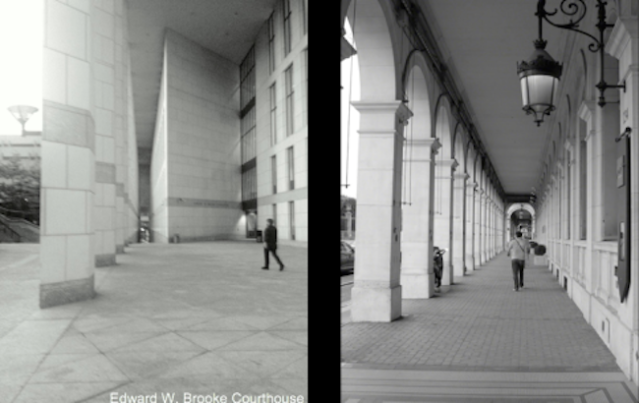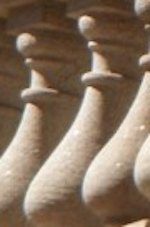
Boston City Hall and Paris street arcade (rue de Rivoli) show little detail and much detail, a factor in which scene most humans prefer to inhabit. (geneticsofdesign.com)
A thrilling new report on how biometric technologies assess human taste in architecture was published yesterday on Common/Edge. As I’ve said before, good on C/E for running an essay, as it occasionally does, that refrains from trashing new traditional architecture, as it usually does, often in the guise of even-handedness.
I mean that as praise. Most architecture journals are unrelentingly negative in their assessment of new traditional architecture, when they don’t just ignore it. C/E is an important break from convention.
“Game-Changing Eye-Tracking Studies Reveal How We Actually See Architecture” is by architect and researcher Ann Sussman, who sent me the C/E piece the day before yesterday. Then Kristen Richards, the founder and editor of the indispensable ArchNewsNow (ANN) compendium of reporting and criticism on architecture worldwide, sent me Sussman’s piece. She was sure that I’d be interested. So I am actually reading Ann on ANN. Ha ha! Sorry ’bout that, couldn’t resist. But now let’s get serious.
Sussman wrote the essay with Janice Ward. Last year, the two wrote what may be the most in-depth description of Sussman’s findings up to that point. “Planning for the Subconcious” was the cover story for the June 2016 issue of Planning, the magazine of American Planning Association.
In the APA article, the authors are more vague about what eye tracking and other biometric tools (such as EEG to track brain waves) say in regard to how people respond to architecture. They quote architecture professor Mark Collins, of Columbia University, pointing out that “[b]iometric techniques hold so much potential for planning because they ‘make quantifiable what we intuitively know and show us what we don’t expect.'”

Eye tracking by Ann Sussman shows how the eye is drawn to the building above whereas the eye tends to avoid the building below. (geneticsofdesign.com)
Over time, Sussman has become bolder in her willingness to articulate what those tools are telling her. Most emphatically, biometrics tell us that people like to look at other people most, which certainly qualifies as what we already know intuitively. We look at people because people’s faces are the kind of detail that is most interesting to the brain. So our experience of places and individual buildings are more pleasing when the places have more people in them and when the buildings have details that suggest the human face or simply more detail rather than less detail.
And what does that say? It says what we know intuitively, and have seen measured frequently in surveys and anecdotally for decades, that people prefer traditional architecture to modern architecture. The one architecture revels in detail and ornament; the other largely rejects detail and ornament, preferring simple (or blank) spaces that don’t offer up much detail for the human brain to subconsciously enjoy. (For early humans, such detail was a matter of life or death out on the savanah.)
This is both intuitive and, as Collins says, shows us what we don’t expect. Why don’t planners, architects and people in design and artistic circles expect what they know intuitively? Because architecture and design schools have, since the 1950s, purged students of their instinctive respect for beauty, or at least it has taught them to suppress all that, and to express only what is conventional in such circles. And that’s what they do.
Most people have not had an education in architecture, art or design, and so remain capable of acknowledging the feelings they get when they see things that do – or do not – tickle their intuitive respect for beauty. That is a respect built up in all people from a very young age because, unlike other arts, we experience architecture (interior and exterior) minute by minute from near birth through adulthood. Most people have a more sophisticated ability to judge architecture than the experts. This is why adults feel a greater comfort and joy in traditional rather than modernist architecture. They may not be able to design a house, but they certainly can have an opinion of it. People are less confident in their ability to judge art, music and other products of the design world, but they judge it nevertheless. Appreciating traditional architecture is an instinctive response whereas appreciating modernist architecture is a learned response.
The key passage in Sussman’s C/E essay is:
People don’t tend to look at big blank things, or featureless facades, or architecture with four-sides of repetitive glass. Our brains, the work of 3.6 billion years of evolution, aren’t set up for that. This is likely because big, blank, featureless things rarely killed us. Or, put another way, our current modern architecture simply hasn’t been around long enough to impact behaviors and a central nervous system that’s developed over millennia to ensure the species’ survival in the wild. From the brain’s visual perspective, blank elevations might as well not be there.
The sentence beginning with “our current modern architecture” suggests that if we give modern architecture enough time, it will affect the brain in ways that might someday counteract the brain’s love for faces and details. But most people won’t be around 3.6 billion years, or even half of that, or a millionth (3,600 years), waiting for that to happen. Recognizing this fact, architects often argue that people just don’t “understand” why modern architecture is superior to traditional architecture. They simply need to be re-educated. Well, good luck with that!
Meanwhile, research in more basic biological and mathematical fields supports the biometric research by Sussman. Studies in fractals and biological reproduction by the University of Texas mathematician and architectural theorist Nikos Salingaros, partly in association with architect and complexity theorist Christopher Alexander, show how architectural change mimics biological processes in nature. This research, which was initiated decades ago, confirms that architectural processes change in ways that mimic natural reproductive processes. Builders over centuries and millennia select best practices through trial and error that reflect almost Darwinistic incentives. Architects of every stripe design under the influence of this historical methodology, though traditional work fits more easily into the resulting biological parameters than modernist work.

My own evidence for what Sussman has found is in the photograph at left, a detail from my blog’s header. It is the balustrade in front of the Providence Public Library. The baluster is my favorite architectural feature. I never knew why but it must be because it resembles part of the human body. Some readers see a line of noses – the central if not necessarily the most important feature (the eyes) of a human face. Or maybe it’s a multiple set of … um, well, I don’t want to have to resign from this blog, so I will just say maybe they resemble thoractic appendages of the distaff kind.
Not sure whether my choice was an example of direct or intuitive cognition.
But the key thing is to read Sussman’s essay on Common/Edge. It focuses attention on how many uses are being found for eye tracking technology by product designers and advertising specialists. Very interesting stuff!



Pingback: Eye-Tracking Architecture: Going viral… | The Genetics of Design
Fab!
>
LikeLike
Lieber David–the balustrade is pregnant with possibility…redolent of fecundity.
LikeLike
Ah, another metaphorical possibility. Excellent!
LikeLike
Key sentence: traditional archirecture is an intuitive response; modernist design is a learned response.
LikeLiked by 1 person
Precisely. Modern architecture is a direct result of WWI + the brain damage (PTSD) veterans suffered that prevented their interpretation of environmental stimuli in a neuro-typical, healthy fashion. This disordered thinking (Gropius, Mies, Neutra were all WWI vets) then became institutionalized in American architectural schools in the last century. The approach, brushing aside the past and never curious about the emotional experience of the other; not co-incidentally, matches the criteria for the mental illness in DSM-5.
More at:
http://commonedge.org/the-mental-disorders-that-gave-us-modern-architecture/
LikeLiked by 1 person
I forgot to add to my post a line about the illnesses that beset poor Corbusier, Mies, Gropius, etc. I have commented on their afflictions before, but thanks for sending this information!
LikeLike
David,
Ann’s new essay has the right title: “Game-changing”. I don’t know whether Ann chose it, or Martin Pedersen, the Common Edge editor wisely did so, but it’s entirely appropriate. As you point out, this recent experimental work precisely validates the mathematical descriptions that Christopher and I presented of how human beings respond to forms, shapes, and surfaces.
The old paradigm — a deeply flawed one, based on propaganda and superstition — is out. It will doubtlessly linger on among the deluded and ignorant for a while, but many more people are waking up.
By the way, Ann’s work is having tremendous success in Sweden. Her writings are being translated into Swedish for popular consumption beyond academia (where everyone does read English). A good sign!
Cheers,
Nikos
LikeLiked by 2 people
Unfortunately, the deluded and ignorant include almost everyone of any power or prestige in the realm of design, building and planning, including preservation.
LikeLike